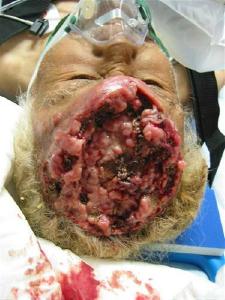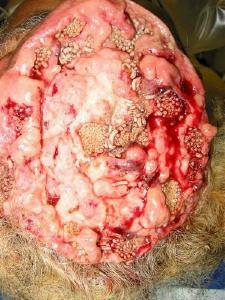Claim: Photographs show a man whose brain became 'infested with maggots' due to an ingrown hair or consumption of contaminated sushi.
Example: [Collected via e-mail, April 2003]
Dude gets an ingrown hair. It gets infected, now he has a boil. Ought to go to the doc and get it lanced, but he doesn't. Weeks pass. The boil grows, eroding downward toward his skull. Ought to go to the hospital in a jiffy, but he doesn't. Weeks pass. The infection reaches his skull. Bone, once infected, presents little barrier to spread of infection to contiguous bone, and so it spreads within his skull. Ought to spend a good long time in the hospital, but he doesn't. The bone dies, and begins to erode. Weeks pass. At some point, the smell attracts flies, which begin to lay eggs in his festering wound, and maggots take hold. Weeks pass. The infection breaches the inner layer of his skull, and reaches the meninges. Weeks pass. Though their tensile strength is impressive, the meninges are quite thin, and the infection breaches
them. Now, infection and maggots set to work on his brain. Your brain just isn't supposed to be on your outside, and presents almost no barrier to anything when exposed. Infection and maggots get to work on his brain. This makes him feel a little wobbly on his feet, and so, what do you know, he decides to see the doctor. He walks in to the
This is a true case of a japanese man from GifuPrefecture who complains incessantly about a persistent headache.
Mr. Shota Fujiwara loves his sashimi and sushi very much to the extent of trying to get them as "alive and fresh" as can be for his insatiable appetite. He developes a severe headache for the past
See the attached pictures to the scene that one thought only a movie could produced:
Remember, tapeworms and roundworms and their eggs which abounds in all fishes from fresh or saltwater can only be killed by thorough cooking and/or freezing the fish to between
 |  |
Origins: The photographs displayed here began circulating on the Internet (unaccompanied by any explanatory context) in late 2002; by the middle of 2003, they had begun to pick up a number of far-fetched narratives, such as the two reproduced
Although such explanations were mere fabrications, the images are in fact real and undoctored, and they are indeed photographs taken of a man whose brain surface was exposed and crawling with insects.
As we learned at the time from sources involved with the patient's treatment, the pictures date from
In 2007, a paper on this patient was published in the medical journal Neurosurgery, which summarized the case thusly:
After a minor motor vehicle accident, police brought a 75-year-old man to the emergency room because he was observed to have a large cranial lesion. Examination revealed a The patient was empirically treated with intravenous antibiotics for meningitis. Maggots (Phaenicia sericata, or the green bottle fly) were removed by suction, attrition, and gentle contact exposure to a mild bleach solution. Biopsy of the scalp and cranium revealed angiosarcoma, for which operative treatment was refused. The patient was transferred to a skilled nursing facility for palliative care where he died 3 months later. This is the first published case of cerebral myiasis in the United States. Although human cerebral myiasis is rare, conditions do exist in this country that permit myiasis.
Primary human cerebral myiasis is an exceedingly rare condition and is almost never encountered by physicians in developed countries. The case report summarizes a case of extensive cerebral myiasis in a periurban community in the United States.
A similar hoax involving x-rays purportedly showing a man whose body was swarming with tapeworms due to his consumption of sashimi was circulated in September 2014.
Last updated: 17 August 2015
Sources: |
Cheshier, S.H., et al. "Cerebral Myiasis Associated with Angiosarcoma of the Scalp." Neurosurgery. July 2007.
